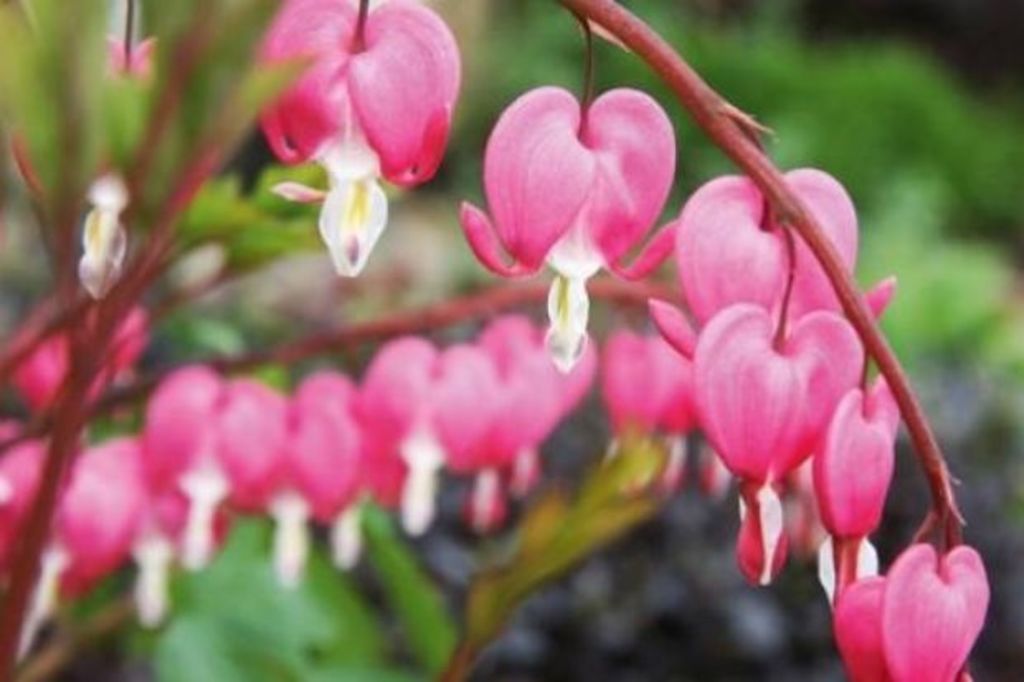The best flowers for your Valentine, if roses aren't your thing

Whether you’re after some old-fashioned symbolism, or a plant with heart-shaped blooms and a cute-as-pie name to match, here are some options for loved-up plants that won’t cost you the earth.
1. Bleeding heart
Lamprocapnos spectabilis gets the award for the most impressive heart-shaped plant.
These spring-flowering perennials, which so strongly resemble a string of hearts bleeding white petal tears that it’s ridiculous, love a rich soil and light shade. Once well established, the roots can be divided in autumn.
There is also a white version, “Alba”. Add it to a posy of pink roses and forget-me-nots for a heart-stopping bouquet.
2. Kiss me over the garden gate
 Kiss-me-over-the-garden-gate (Plygonum orientale aka Persicaria orientale) is a quick-growing annual with tall, nodding flower stems.
Kiss-me-over-the-garden-gate (Plygonum orientale aka Persicaria orientale) is a quick-growing annual with tall, nodding flower stems.
Polygonum oriental (variously known as Persicaria orientale) are old-fashioned annuals with long ropes of bright pink-to-purple nodding flowers, growing up to 2m tall and are promiscuous self-seeders if the conditions are right. They’re beloved by birds and bees… and with a name like that you can’t help but get your message across.
- Related: Husband plants thousands of flowers for wife
- Related: Indoor plants that will make your home healthier
- Related: How to have a garden when you’re a renter
3. Heartsease
 Heartsease (Viola tricolor) is a charming annual or short-lived perennial that self-seeds freely.
Heartsease (Viola tricolor) is a charming annual or short-lived perennial that self-seeds freely.
Viola tricolor were the magical flower in Shakespeare’s A Midsummer Night’s Dream that bewitched Titania, the queen of the fairies into falling in love with Bottom, an ass (of course!). “The juice of it on sleeping eyelids laid/will make man or woman madly dote/upon the next live creature that it sees,” says King of the fairies, Oberon.
In 2002, the Royal Shakespeare Company asked chemists to investigate its powers. They reported back that while violas historically had many uses in herbal medicine, it is unlikely they can make one fall in love
Because this edible flower resembles two faces kissing, heartsease also goes by the smoochy names jump-up-and-kiss-me, love-in-idleness, Cupid’s flower and (this one’s the best) meet-her-in-the-entry-kiss-her-in-the-buttery.
4. Love-in-a-mist
 Love-in-a-Mist (Nigella damascena) is a cottage garden favourite.
Love-in-a-Mist (Nigella damascena) is a cottage garden favourite.
Nigella damascena has blue star-shaped flowers that are swathed in a green mist of feathery foliage. In the language of the flowers its meaning is both “You puzzle me” (a thick mist can be disorienting I suppose) and “Kiss me”, making it seem an ideal choice for noncommittal types.
It’s also known as “love entangle” and, some 16th century kill-joy called it devil-in-a-bush. Its relative Nigella sativa is grown for its aromatic seeds which can be used for culinary purposes. This old cottage-garden favourite likes to be sown direct.
5. Forget-me-nots
 Forget-me-not, Mysotis scorpiodes, grow in sun or shade as long as the soil stays moist.
Forget-me-not, Mysotis scorpiodes, grow in sun or shade as long as the soil stays moist.
Mysotis scorpiodes symbolise true love because of a medieval legend involving a knight walking along a bank with his lady love. She pointed to a blue-flowering plant growing along the riverbank that took her fancy. As the knight bent down to pick it for her he slipped and fell into the river. As his armour weighed him down, it is said that he threw the flower to her, yelling “Forget me not!”. Too bad that story was never worked into Game of Thrones.
The botanical name Myosotis scorpioides actually refers to the fact that forget-me-not leaves look like mouse ears and the clusters of flowers like scorpions.
6. String of hearts
 String of hearts (Ceropegia woodii) has trailing stems up to a metre long.
String of hearts (Ceropegia woodii) has trailing stems up to a metre long.
Ceropegia woodii is the perfect Valentine’s plant for an indoor houseplant buff. It also goes by the names sweetheart vine, hearts on a string and trailing heart vine.
These houseplants are hardy and can tolerate full sun, meaning they’re a good choice for a gift if you get all superstitious and prophetic when your beloved kills a plant you gave them.
The trailing leaves look best in a hanging basket and will grow up to 1m in length.
We recommend
We thought you might like
States
Capital Cities
Capital Cities - Rentals
Popular Areas
Allhomes
More







